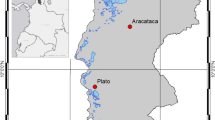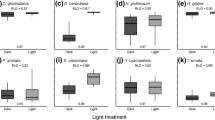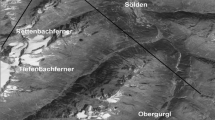Abstract
Variation in vegetation density creates a range of red to far-red ratios of irradiance (R:FR) potentially permitting fine-scale discrimination of light conditions for seed germination. However, remarkably few studies have explored whether R:FR responses of germination vary among species that differ in distribution and life-history traits. In this study, we explored the relationships between R:FR requirements and four species characteristics: seed mass, latitudinal distribution (tropical vs. temperate), seed dormancy (dormant vs. nondormant), and plant growth form (woody vs. nonwoody). We obtained data on germination response to R:FR of 62 species from published literature and added new data for ten species from aseasonal tropical forests in Borneo. First, we analyzed whether species characteristics influenced overall light dependency of germination using phylogenetic logistic regression. We found that seed mass had a strong negative effect on light dependency, but that the seed mass at which tropical taxa had a 50 % probability of light dependency was 40 times that of temperate taxa. For light-dependent species, we found that the threshold R:FR that stimulates 50 % of maximum germination (R:FR50) was also related to seed mass and latitudinal distribution. In agreement with an earlier study, we found that for temperate taxa, the R:FR50 was significantly negatively correlated with seed mass. In contrast, for 22 tropical taxa, we found a significant positive correlation. These opposing relationships suggest contrasting selection pressures on germination responses of tropical taxa (mostly trees) and temperate herbaceous plants, and which are likely related to differences in seed longevity, seed burial rates, and reproductive output.



Similar content being viewed by others

References
Ahola V, Leinonen K (1999) Responses of Betula pendula, Picea abies, and Pinus sylvestris seeds to red/far-red ratios as affected by moist chilling and germination temperature. Can J For Res 29:1709–1717
Angiosperm Phylogeny Group (2009) An update of the Angiosperm Phylogeny Group classification for the orders and families of flowering plants: APG III. Bot J Linn Soc 161:105–121
Baskin CC, Baskin JM (1998) Seeds: ecology, biogeography, and evolution of dormancy and germination. Academic Press, California
Baskin CC, Milberg P, Andersson L, Baskin JM (2000) Germination studies of three dwarf shrubs (Vaccinium, Ericaceae) of Northern Hemisphere coniferous forests. Can J Bot 78:1552–1560
Batlla D, Kruk BC, Benech-Arnold RL (2000) Very early detection of canopy presence by seeds through perception of subtle modifications in red:far red signals. Funct Ecol 14:195–202
Bell DT, King LA, Plummer JA (1999) Ecophysiological effects of light quality and nitrate on seed germination in species from Western Australia. Aust Ecol 24:2–10
Benvenuti S (1995) Soil light penetration and dormancy of jimsonweed (Datura stramonium) seeds. Weed Sci 43:389–393
Bewley JD, Black M (1994) Seeds: physiology of development and germination. Plenum Press, New York
Cerabolini B, Ceriani RM, Caccianiga M, De Andreis R, Raimondi B (2003) Seed size, shape and persistence in soil: a test on Italian flora from Alps to Mediterranean coasts. Seed Sci Res 13:75–85
Corlett RT (2009) Seed dispersal distances and plant migration potential in tropical East Asia. Biotropica 41:592–598
Dalling JW, Brown TA (2009) Long-term persistence of pioneer species in tropical rain forest soil seed banks. Am Nat 173:531–535
Dalling JW, Swaine MD, Garwood NC (1997) Soil seed bank community dynamics in seasonally moist lowland tropical forest, Panama. J Trop Ecol 13:659–680
Dalling JW, Swaine MD, Garwood NC (1998) Dispersal patterns and seed bank dynamics of pioneer trees in moist tropical forest. Ecology 79:564–578
Dalling JW, Muller-Landau HC, Wright SJ, Hubbell SP (2002) Role of dispersal in the recruitment limitation of neotropical pioneer species. J Ecol 90:714–727
Daws MI, Burslem DFRP, Crabtree LM, Kirkman P, Mullins CE, Dalling JW (2002) Differences in seed germination responses may promote coexistence of four sympatric Piper species. Funct Ecol 16:258–267
Daws MI, Ballard C, Mullins CE, Garwood NC, Murray B, Pearson TRH, Burslem DFRP (2007) Allometric relationships between seed mass and seedling characteristics reveal trade-offs for neotropical gap-dependent species. Oecologia 154:445–454
Daws MI, Crabtree LM, Dalling JW, Mullins CE, Burslem DFRP (2008) Germination responses to water potential in neotropical pioneers suggest large-seeded species take more risks. Ann Bot 102:945–951
De Villiers AJ, Van Rooyen MW, Theron GK (2002) Germination strategies of Strandveld Succulent Karoo plant species for revegetation purposes: I. Temperature and light requirements. Seed Sci Technol 30:17–33
De’ath G, Fabricius KE (2000) Classification and regression trees: a powerful yet simple technique for ecological data analysis. Ecology 81:3178–3192
Denslow JS (1987) Tropical rainforest gaps and tree species diversity. Annu Rev Ecol Syst 18:431–451
Dobarro I, Valladares F, Peco B (2010) Light quality and not quantity segregates germination of grazing increasers from decreasers in Mediterranean grasslands. Acta Oecol 36:74–79
Elsevier (2012) SciVerse SCOPUS database
Engelbrecht BMJ, Dalling JW, Pearson TRH, Wolf RL, Gálvez DA, Koehler T, Tyree MT, Kursar TA (2006) Short dry spells in the wet season increase mortality of tropical pioneer seedlings. Oecologia 148:258–269
Felsenstein J (1985) Phylogenies and the comparative method. Am Nat 125:1–15
Flores J, Jurado E, Chapa-Vargas L, Ceroni-Stuva A, Dávila-Aranda P, Galíndez G, Gurvich D, León-Lobos P, Ordóñez C, Ortega-Baes P, Ramírez-Bullón N, Sandoval A, Seal CE, Ullian T, Pritchard HW (2011) Seed photoblastism and its relationship with some plant traits in 136 cacti taxa. Environ Exper Bot 71:79–88
Funes G, Basconcelo S, Díaz S, Cabido M (1999) Seed size and shape are good predictors of seed persistence in soil in temperate mountain grasslands of Argentina. Seed Sci Res 9:341–345
Galíndez G, Ortega-Baes P, Daws MI, Sühring S, Scopel AL, Pritchard HW (2009) Seed mass and germination in Asteraceae species of Argentina. Seed Sci Technol 37:786–790
Grafen A (1989) The phylogenetic regression. Phil Trans R Soc Lond B 326:119–157
Grubb PJ (1977) Maintenance of species-richness in plant communities: importance of regeneration niche. Biol Rev 52:107–145
Jankowska-Blaszczuk M, Daws MI (2007) Impact of red : far red ratios on germination of temperate forest herbs in relation to shade tolerance, seed mass and persistence in the soil. Funct Ecol 21:1055–1062
Jones FA, Chen J, Weng G, Hubbell SP (2005) A genetic evaluation of seed dispersal in the neotropical tree Jacaranda copaia (Bignoniaceae). Am Nat 166:543–555
Kostel-Hughes F, Young TP, Wehr JD (2005) Effects of leaf litter depth on the emergence and seedling growth of deciduous forest tree species in relation to seed size. J Torrey Bot Soc 132:50–61
Kumagai T, Yoshifuji N, Tanaka N, Suzuki M, Kume T (2009) Comparison of soil moisture dynamics between a tropical rain forest and a tropical seasonal forest in Southeast Asia: impact of seasonal and year-to-year variations in rainfall. Water Resour Res 45:W04413. doi:10.1029/2008WR007307
Lee DW (1987) The spectral distribution of radiation in two neotropical rainforests. Biotropica 19:161–166
Leishman MR, Westoby M (1998) Seed size and shape are not related to persistence in soil in Australia in the same way as in Britain. Funct Ecol 12:480–485
Lieberman M, Lieberman D, Peralta R (1989) Forests are not just Swiss cheese: canopy stereogeometry of non-gaps in tropical forests. Ecology 70:550–552
Marthews TR, Mullins CE, Dalling JW, Burslem DFRP (2008) Burial and secondary dispersal of small seeds in a tropical forest. J Trop Ecol 24:595–605
Martins LST, Pereira TS, Carvalho ASDR, Barros CF, De Andrade ACS (2012) Seed germination of Pilosocereus arrabidae (Cactaceae) from a semiarid region of south-east Brazil. Plant Species Biol 27:191–200
Milberg P, Andersson L, Thompson K (2000) Large-seeded species are less dependent on light for germination than small-seeded ones. Seed Sci Res 10:99–104
Moles AT, Hodson DW, Webb CJ (2000) Seed size and shape and persistence in the soil in the New Zealand flora. Oikos 89:541–545
Molofsky J, Augspurger CK (1992) The effect of leaf litter on early seedling establishment in a tropical forest. Ecology 73:68–77
Muller-Landau HC (2010) The tolerance-fecundity trade-off and the maintenance of diversity in seed size. Proc Natl Acad Sci USA 107:4242–4247
Paradis E, Claude J (2002) Analysis of comparative data using generalized estimating equations. J Theor Biol 218:175–185
Pearson TRH, Burslem DFRP, Mullins CE, Dalling JW (2002) Germination ecology of neotropical pioneers: interacting effects of environmental conditions and seed size. Ecology 83:2798–2807
Pearson TRH, Burslem DFRP, Mullins CE, Dalling JW (2003) Functional significance of photoblastic germination in neotropical pioneer trees: a seed’s eye view. Funct Ecol 17:394–402
Pereira AR, Andrade ACS, Pereira TS, Forzza RC, Rodrigues AS (2009) Germination behaviour of epiphyte and rupicolous Bromeliaceae species from Ibitipoca State Park, Minas Gerais, Brazil. Rev Bras Bot 32:827–838 (in Portuguese with English abstract)
Pereira AR, Andrade ACS, Pereira TS, Forzza RC, Rodrigues AS (2010) Morphological aspects of seed, germination and storage of Pitcairnia albiflos (Bromeliaceae). Seed Sci Technol 38:79–87
Pons TL (1983) Significance of inhibition of seed germination under the leaf canopy in ash coppice. Plant Cell Environ 6:385–392
Pons TL (1986) Response of Plantago major seeds to the red/far-red ratio as influenced by other environmental factors. Physiol Plant 68:252–258
Pons TL (1991) Dormancy, germination and mortality of seeds in a chalk-grassland flora. J Ecol 79:765–780
Rojas-Aréchiga M, Orozco-Segovia A, Vázquez-Yanes C (1997) Effect of light on germination of seven species of cacti from the Zapotitlán Valley in Puebla, México. J Arid Environ 36:571–578
Royal Botanic Gardens Kew (2008) Seed Information Database (SID). Version 7.1. http://data.kew.org/sid/. Accessed April 2012
Smith H (2000) Phytochromes and light signal perception by plants- an emerging synthesis. Nature 407:585–591
R Core Team (2013). R: A language and environment for statistical computing. R Foundation for Statistical Computing, Vienna. http://www.R-project.org/. Accessed 26 March 2013
Thompson K, Grime JP (1983) A comparative study of germination responses to diurnally-fluctuating temperatures. J Appl Ecol 20:141–156
Thompson K, Band SR, Hodgson JG (1993) Seed size and shape predict persistence in soil. Funct Ecol 7:236–241
Vandelook F, Van De Moer D, Van Assche JA (2008) Environmental signals for seed germination reflect habitat adaptations in four temperate Caryophyllaceae. Funct Ecol 22:470–478
Vásquez-Yanes C, Orozco-Segovia A, Rincon E, Sanchez-Coronado ME, Huante P, Toledo JR, Barradas VL (1990) Light beneath the litter in a tropical forest: effect on seed germination. Ecology 71:1952–1958
Webb CO, Donaghue MJ (2005) Phylomatic: tree assembly for applied phylogenetics. Mol Ecol Notes 5:181–183
Webb CO, Ackerly DD, Kembel SW (2008) Phylocom: software for the analysis of phylogenetic community structure and trait evolution. Bioinformatics 24:2098–2100
Wikström N, Savolainen V, Chase MW (2001) Evolution of the angiosperms: calibrating the family tree. Proc Biol Sci 268:2211–2220
Wooley JT, Stoller EW (1978) Light penetration and light induced seed germination in soil. Plant Physiol 61:597–600
Yirdaw E, Leinonen K (2002) Seed germination responses of four afromontane tree species to red/far-red ratio and temperature. For Ecol Manag 168:53–61
Acknowledgments
The authors thank Yuji Tokumoto for help in providing Dillenia suffruticosa seeds. The authors express their gratitude to Carol Augspurger, Adam Davis, and two anonymous reviewers for helpful comments on the study. This study is partly funded by the 2010 grant program of the Center for Tropical Forest Science and Royal Thai Government Scholarship.
Author information
Authors and Affiliations
Corresponding author
Rights and permissions
About this article
Cite this article
Tiansawat, P., Dalling, J.W. Differential seed germination responses to the ratio of red to far-red light in temperate and tropical species. Plant Ecol 214, 751–764 (2013). https://doi.org/10.1007/s11258-013-0205-y
Received:
Accepted:
Published:
Issue Date:
DOI: https://doi.org/10.1007/s11258-013-0205-y



